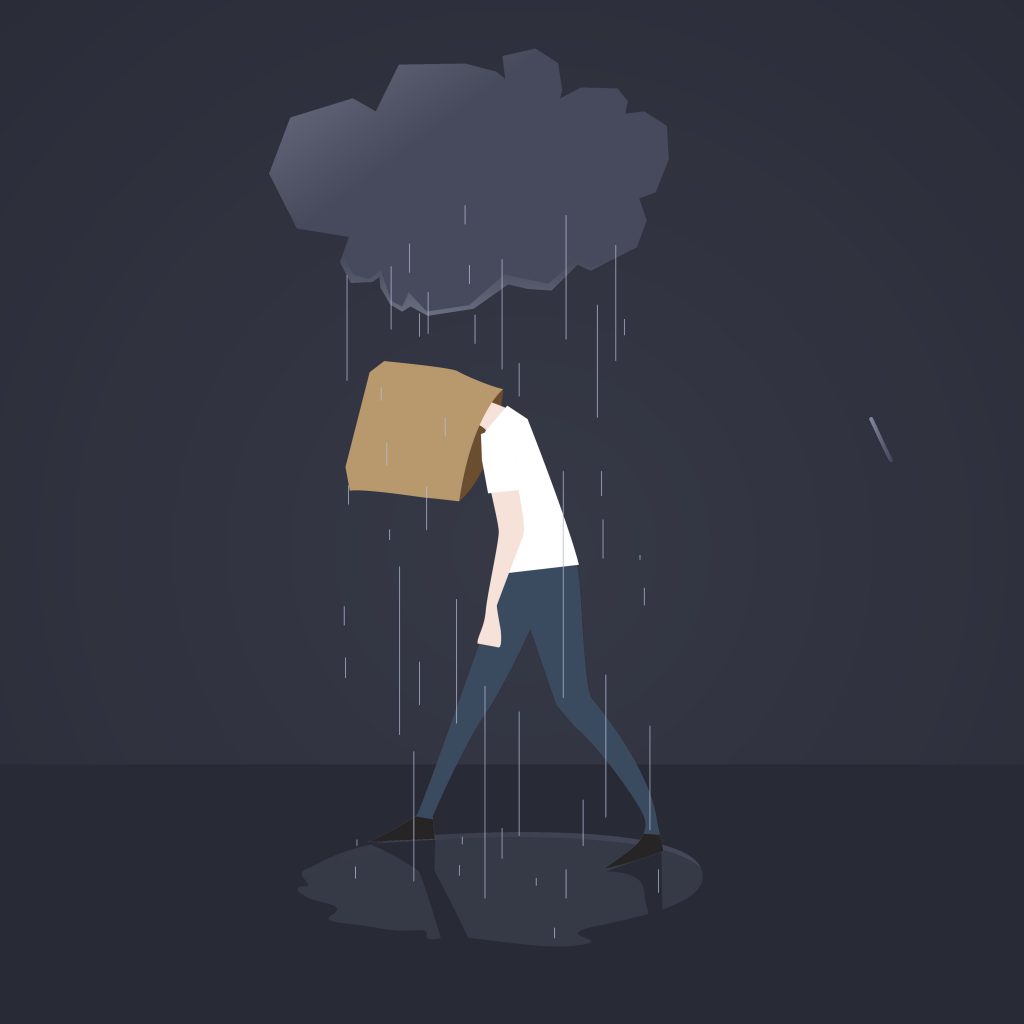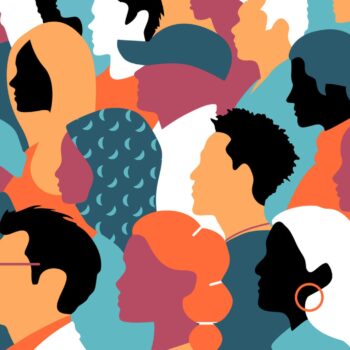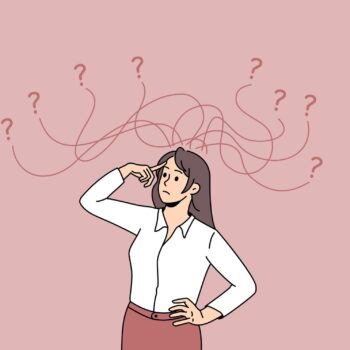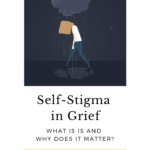Self-Stigma in Grief: What Is It and Why Does It Matter?
/ Understanding Grief : Eleanor Haley
For further articles on these topics:
Death, loss, and grief are experiences that impact almost every being on Earth at some point. These universal experiences touch everyone and so it follows that everyone would have their own unique set of beliefs, attitudes, and opinions about these things.
Some of these attitudes we might classify as 'accurate, compassionate, empathetic, and/or otherwise helpful' and some we might classify as 'myth, misconception, and/or otherwise sucky'. I'm sorry to say, our discussion today begins with an examination of the latter because, as the title of this article suggests, we are discussing self-stigma.
Self-stigma begins with the negative attitudes and stereotypes a person encounters in the outside world that they then internalize and apply to themselves. This is reflected in the definition laid out here by Corrigan and Rao (2012):
"Public stigma refers to the negative attitudes held by members of the public about people with devalued characteristics. Self-stigma occurs when people internalize these public attitudes and suffer numerous negative consequences as a result."
In order to understand the types of negative attitudes at the heart of grief related stigma, one needs to look no further than our article, '64 of the Worst Things Ever Said to a Griever' article to get a taste. (Glass-half-full people, don't worry, we also have an article about the best things ever said to a griever.) We've summarized a handful of these statements below.
Statements Like:
“What did he go and do now?”
“What did you think was going to happen? He was a drug addict!”
"This was obviously what she wanted.”
Implied attitudes: The death was the loved one's fault or choice. The loved one was deserving of death. The grieving person ought to feel less grief because they should have seen the death coming, the deceased was troubled or bad, or because the death was a choice or consequence.
Statements Like:
“You need to stop feeling sorry for yourself and move on."
"I thought you’d be over it by now!”
Implied attitudes: People should be able to get over their grief and move on. There are timeframes for grief. Things like empathy and understanding from others are time-limited. It's weak to continue to grieve for 'X' amount of time.
Statements Like:
"People have been through worse."
“Losing your husband is nothing compared to the death of a parent. You can always replace your husband.”
"At least he made it to 92."
Implied Attitudes: You are weak compared to others. Certain types of loss are less valid and significant than others. Certain types of loss are less deserving of grief, sympathy, and support than others. Your loved one is replaceable.
Statements Like:
"Buck up!"
“I am going to hang up now – call me back when you stop crying.”
Implied Attitudes: You need to be stronger and less emotional. Your grief is unacceptable. Your expression of grief and emotion is abnormal or undesirable.

How Self-Stigma is Formed:
Before you ask, yes, these are actual statements said to people in their time of grief. We like to give the benefit of the doubt and acknowledge that people do sometimes say things they don't mean. However, even when the harm is unintentional, a person's words quite often reflect the implicit attitudes and biases that they've picked up over the years.
We did, of course, draw assumptions about the implied attitudes that lie below the surface of the statements, but it's a useful exercise because this is exactly what happens in the real world when these things are said to grieving people and it helps to illustrate where the seeds of self-stigma may begin.
Even if a statement has not been said to a person if they've heard it expressed in any form - whether about a friend, community member, celebrity or TV character - they now know it exists. And according to Bruce Link and colleagues who developed modified labeling theory, awareness is the first of three steps involved in the formation of self-stigma. The second step in the formation of self-stigma is 'agreement' where a person decides whether or not they buy into the attitude, bias, or stereotype; and the third is 'application' where the person applies the stereotype to themselves.
Now, you may wonder why anyone would agree with and apply some of the attitudes illustrated above, and many people thankfully won't, but for those who do, you have to consider the many forces at play. A few examples include:
- Attitudes formed before the loss: Long before experiencing a loss of their own, a person forms beliefs and attitudes about emotion, grief, and the many circumstances that precede and follow deaths of all kinds. Some of these beliefs may be helpful in the person's grief and some may reflect negative attitudes and stereotypes.
- Negative messages and statements: If a person is exposed to negative messages and statements from those around them about their loved one, their loved one's death, and their grief, they may begin to buy into them. In general, myths and misconceptions often lead to insensitive and ineffective grief support. And there is plenty of research indicating that those whose loved ones have died from disenfranchised losses (like suicide or overdose) are especially likely to experience a lack of support and a dearth of hurtful comments.
- Blame, guilt, shame, regret, fear of emotion: Many common and natural grief reactions can contribute to negative beliefs about who is to blame, who is deserving of sympathy, who is responsible, and self-efficacy with regards to coping with grief.
We are going to take a minute to discuss the impact of self-stigmatization and a few ways to cope with it, but before doing so we'd like to ask you to ask yourself whether you think you've applied negative attitudes, stereotypes, and beliefs to yourself, your loved one, or your grief in any way. If you have, you're definitely not alone. I'm going to go out on a limb and say we all fall victim of this from time to time, and just as awareness is the first step in self-stigma formation, it's also probably the first step in coping with it.
The Potential Impact of Self-Stigma:
Some of the potential negative impacts of self-stigma include.
The 'why try' effect: Public and self-stigma may impact an individual's desire to seek out support, connection, coping, and healing. They may feel that trying is futile; worry that 'trying' will only expose themselves to further negativity, frustration, and harm; or feel that they aren't deserving of more positive, constructive, or healing experiences.
Self-discrimination: Negative self-beliefs will more than likely have an impact on behavior. In this way, negatively held stereotypes about oneself may lead to self-discrimination and disenfranchisement. For example, a person who believes their loss is less valid than other losses may say to themselves "I don't belong in a support group because my grief is less significant", "I don't deserve support", or "I don't deserve to feel this amount of grief".
Avoidance/Social Isolation: A person may avoid situations where they feel they don’t belong, where they worry they will be discriminated against, or that they feel unworthy of.
Secrecy/Emotional Isolation: When a person feels ashamed or has an awareness that a certain stigma could exist - they may choose complete secrecy to avoid discrimination. Obviously, many people choose to keep things private for a range of very valid reasons. However, when a person feels they don't have anyone they can be open and authentic with, they may experience emotional isolation and they may cut themselves off from receiving support altogether.
Decreases in self-esteem: Obviously, negative self-beliefs like "I'm weak" "I'm not capable" "I'm to blame" "I deserve bad" and "I don't deserve good" have the capacity to eat away at a person's self-esteem.
Coping with Self-Stigma:
Below are a few thoughts on coping with self-stigma.
Learn about self-compassion: Check out our article on the need for self-compassion in grief
Help educate society about grief and disenfranchised losses: Remember, stigma usually begins with the negative attitudes and stereotypes of a broader society. Quoting again from Corrigan and Rao (2012), "Stigma is social injustice and an error of society. Hence, eradicating it is the responsibility and should be the priority of that society.
Seek peer support: Whether through one-on-one contact or support groups, those who have been through similar experiences may be less inclined to endorse negative stereotypes and may be more likely to show compassion and understanding for your grief related experiences.
One-on-one counseling: Everyone deserves a safe space where they feel comfortable exploring and expressing their experiences. If you don't feel like you can trust those in your support system and you don't feel comfortable attending a support group, a one-on-one counselor is often a good solution. A counselor ought to be able to provide a non-judgemental environment where you can work together to: learn more about issues related to your loved one's death and grief, examine and challenge negative beliefs and attitudes about yourself, your loved one and your experiences, and find ways to communicate with those in your life who are less than helpful.
Subscribe to receive posts straight to your email inbox.
We wrote a book!
After writing online articles for What’s Your Grief
for over a decade, we finally wrote a tangible,
real-life book!
What’s Your Grief? Lists to Help you Through Any Loss is for people experiencing any type of loss. This book discusses some of the most common grief experiences and breaks down psychological concepts to help you understand your thoughts and emotions. It also shares useful coping tools, and helps the reader reflect on their unique relationship with grief and loss.
You can find What’s Your Grief? Lists to Help you Through Any Loss wherever you buy books:






Shelley Coleman October 27, 2019 at 7:07 am
My husband died by suicide. We had a troubled marriage. The loss was – and is – very painful. Potential damage was avoided by the self stigma awareness when I would hear comments such as: “Why are you so sad?” “It was just a matter of time” “he was trying to kill himself for years”. The people were trying to help but the comments were negative. Having access to information and a sounding board here is a valuable tool for us all. Thank you.
Chris June 11, 2019 at 10:44 pm
I was told by a couple that it is time to move on. I think that they were hoping for a more fun night when they came to visit me. I moved on from that friendship.
My mother reminded me of a fight that I had with him, and regurgitated back some of the things that I had vented to her. The implication was that if I felt THAT way about him, why was I so sad?
It really sucks that we internalize these things, which I did. That said, I am also really fortunate to have some really good people in my life who understand that I melt down sometimes after two years. When I first encountered the idea that not all of our relationships survive our grief, it didn’t make sense to me. It does now. And, I think that this is ok.
I have a ton of gratitude for What’s Your Grief, because you are so good about elucidating the complexity of loss. It makes me feel less alone.
Anna June 7, 2019 at 10:01 pm
Does self signs refer to the personalization of grief? Or these things happen to me…